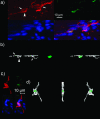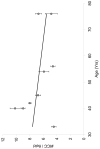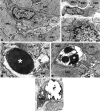Apoptotic cell death of human interstitial cells of Cajal
- PMID: 18798796
- PMCID: PMC2627790
- DOI: 10.1111/j.1365-2982.2008.01185.x
Apoptotic cell death of human interstitial cells of Cajal
Abstract
Interstitial cells of Cajal (ICC) are specialized mesenchyme-derived cells that regulate contractility and excitability of many smooth muscles with loss of ICC seen in a variety of gut motility disorders. Maintenance of ICC numbers is tightly regulated, with several factors known to regulate proliferation. In contrast, the fate of ICC is not established. The aim of this study was to investigate whether apoptosis plays a role in the regulation of ICC numbers in the normal colon. ICC were identified by immunolabelling for the c-Kit receptor tyrosine kinase and by electron microscopy. Apoptosis was detected in colon tissue by immunolabelling for activated caspase-3, terminal dUTP nucleotide end labelling and by ultrastructural changes in the cells. Apoptotic ICC were identified and counted in double-labelled tissue sections. They were identified in all layers of the colonic muscle. In the muscularis propria 1.5 +/- 0.2% of ICC were positive for activated caspase-3 and in the circular muscle layer 2.1 +/- 0.9% of ICC were positive for TUNEL. Apoptotic ICC were identified by electron microscopy. Apoptotic cell death is a continuing process in ICC. The level of apoptosis in ICC in healthy colon indicates that these cells must be continually regenerated to maintain intact networks.
Figures






References
-
- Thomsen L, Robinson TL, Lee JC, et al. Interstitial cells of Cajal generate a rhythmic pacemaker current. Nature Med. 1998;4:848–51. - PubMed
-
- Huizinga JD, Thuneberg L, Kluppel M, Malysz J, Mikkelsen HB, Bernstein A. W/kit gene required for interstitial cells of Cajal and for intestinal pacemaker activity. Nature. 1995;373:347–9. - PubMed
Publication types
MeSH terms
Grants and funding
LinkOut - more resources
Full Text Sources
Research Materials

